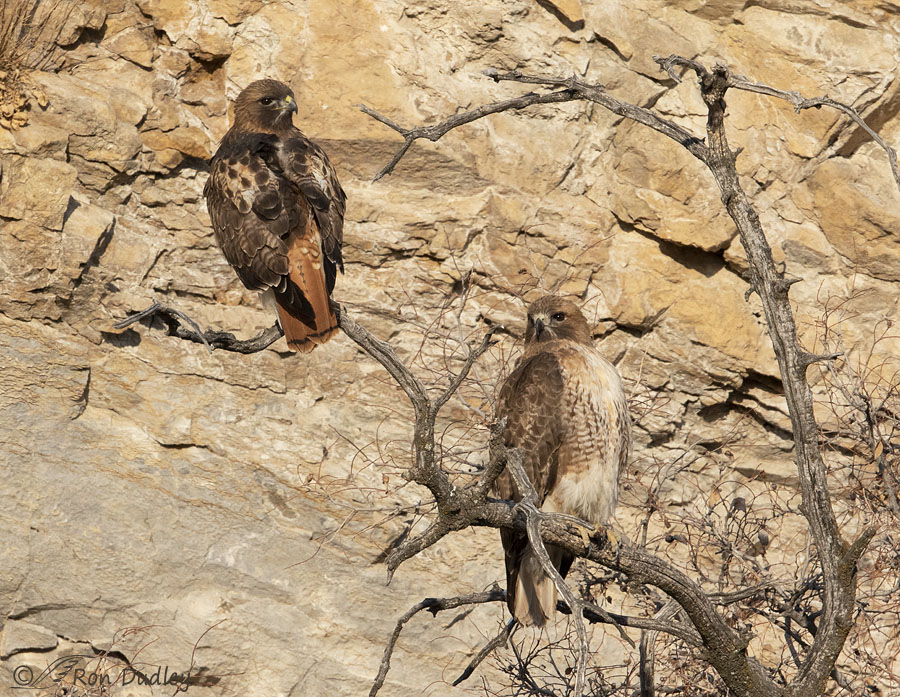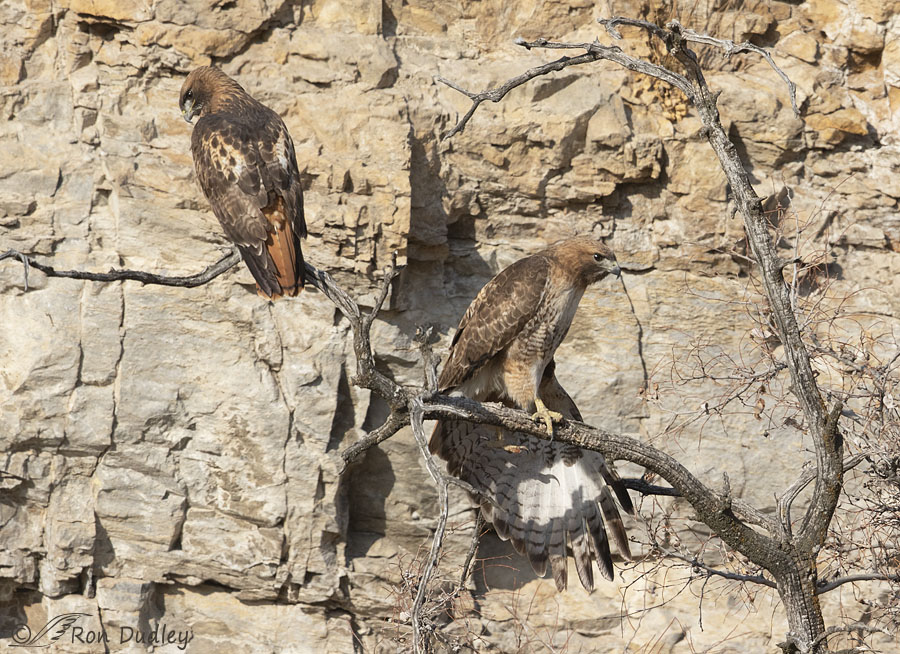Harsh midday light is not the photographer’s friend but the warm glow of the ‘golden hour’ is transitory and often elusive, especially if you aren’t a ‘morning person’.
The first hour after sunrise and the last hour before sunset are coveted by experienced photographers for the signature warm glow of the light it provides. The natural light of the golden hour is easier for the photographer to work with. It’s less likely to overexpose or underexpose parts of the image because the light is more even and has a pleasing golden hue. With the sun low in the sky the light is softer, more directional and warmer.
But it sure doesn’t last long.

1/1250, f/14, ISO 800, Canon 7D Mark II, Canon EF 500mm f/4L IS II USM + EF 1.4 III Extender, not baited, set up or called in
Two days ago when I arrived on site to photograph one of the nesting pairs of Red-tailed Hawks I’ve been following I found both of them basking in the early morning sun in a tree near the nest. Even though they were perched low and close to the road they were incredibly relaxed in my presence. The larger female is the bird on the right and the gorgeously dark male is the hawk at upper left.
This photo was taken about a half hour after sunrise so the light is quite warm, but not as warm as it would have been in the previous 30 minutes. The warm light has softened the typically harsh light on the cliff face behind them and intensified the rich colors of the male in particular.
Soon after this photo was taken I inched my pickup forward a few feet to the viewer’s right in an effort to make the smaller angled branch in front of the female’s right wing and tail…

1/3200, f/7.1, ISO 500, Canon 7D Mark II, Canon EF 500mm f/4L IS II USM + EF 1.4 III Extender, not baited, set up or called in
less obtrusive. By now both birds were becoming a little more active so I caught the female in a wing and leg stretch and the male was beginning to look below him for nesting material to deliver to the nest. I may post photos of his efforts at a later time.
This image was taken 29 minutes after the previous one (I told you they were relaxed). By now the desirable effects of the golden hour were dissipating so the light is noticeably harsher, the colors of the cliff face and the male in particular are much less rich and saturated and there’s little detail in some of the whites of the female’s outstretched left wing (although I do like the way the brighter light makes the shadow of her talon stand out).
I’m not saying the warm light of the golden hour is a panacea, it isn’t. Depending on taste, in some situations very warm light can be too warm. For example I’m not a fan of warm light on black and/or white birds. But overall most folks in most situations covet warm light in their photos and I’m one of them.
Personally I much prefer the warm light in the first photo over the cooler light in the second but your mileage may vary.
Ron
Notes:
- Living where I do I’m at a distinct disadvantage when it comes to utilizing the warm light of the golden hour, especially in the mornings. In many of the places I photograph birds there are 12,000′ mountains not far to the east so for the first half hour or so after official sunrise I’m still in shade. Even so I still love those mountains.
- Another advantage to the bird photographer of shooting in the golden hour has more to do with the angle of light than the quality of light. As readers know a catch light in the eye is extremely important for quality bird photography but the higher the sun is in the sky the more difficult it becomes to get light in the eye. Because of their overhanging brow ridge this is especially true with most raptors.


Both shots are gorgeous! Love the wing and talon stretch in the 2nd shot. Am a big fan of ‘couples’ photos 🙂
The golden hour is certainly best for the Bald Eagles in our neighborhood. Bright daylight makes It so easy to blow out their white heads and shadow out their undersides. It seems like Love and Marriage– “You can’t have one without the other.”
The light can make a difference. Too bad it doesn’t last but a few moments. Down south, were I am today, the warm glow seems to last longer, I think it is due to the lack of towering mountain ranges to the east and the reflective red colors from the sandstone.
April, I think you’re right about why it seems to last longer down there. I saw the photo you posted from the Kanab area today. I’ve spent a LOT of time in that area over the years. Hope you enjoy your trip.
I love that first shot. In the second, I didn’t even catch the outstretched wing. The light difference may never cease to amaze me.
“The light difference may never cease to amaze me.”
Me too, Arwen. Especially when I can compare before and after photos like these.
If thoses two times are the best, 12 noon is certainly one of the worst……
That’s right, Patty – especially in summer.
Thank you, Ron, for sharing that lovely early morning light change with us. I can touch those rocks and smell that air – wow! Such memories.
Love the talon shadow in #2! And the change in expression in both birds from the peace and glow in #1 to “time to go to work” in #2.
Carolyn
Thanks, Carolyn. That talon shadow catches the eye doesn’t it.
Being not an early-morning person (as evidenced by how late my comments generally are), I know I miss many of these special viewing opportunities, but I’m so glad I can depend on you to show me some of what I’m missing. These are beautiful, beautiful hawks, and I look forward to seeing more of them and, eventually, their progeny—in whatever light you find them! 😎
“Their progeny” – I hope, Chris. Right now that seems so very far away.
Coordinating the right light, the subject, the composition and ensuring proper equipment settings – it may not be rocket science but it sure ain’t as easy as it sounds! Oh, wait. It actually doesn’t even sound easy.
Your consistent results, Ron, prove that experience is the key to success.
It’s one thing to “take a picture of a bird”. It is something quite special, however, to produce an outstanding photograph of a pair of Red-tailed Hawks relaxing together at their nesting site bathed in the warm light of the rising sun.
Magnificent creatures!
Thank you for sharing your special moments with them.
Much appreciated, Wally. And yes, you get it as evidenced by your first sentence.
You are so right about the golden hour – and the images you chose illustrate it perfectly.
Our golden hour is some time off here, but I wait for it each and every day. My partner (given his druthers) springs out of bed at the crack of noon. His loss.
EC, I think we agree that mornings are the very best part of the day.
What a STUNNER shot #1 is– thanks ! you’ve started my day off with “beauty before me”, as the Navajo chant celebrates…..
To add to what you say about the “golden hour” of lighting, when the source
is lower in the sky, a “raking” light angle tends to bump up both the texture and
the dimensional quality of the full form of the subject– painters of desert landscapes. especially appreciate its power.
I agree with your last sentence about texture and dimension, Kris. It’s that way for bird photographers too, although perhaps to a lesser degree.
Your description of perfect light is spot on; it requires a little extra effort, but is very gratifying as you point out. Thanks for the wonderful photos.
Thank you, Don.
Excellent photos both. Love your “incredible relaxed” description for the first photo. I can see and feel that as I look at that setting. There seems to be no apprehension about them concerning your presence. I usually get most of my bird photos during that time period, but as you point out with your mountains there is often a problem with hills, trees, and other obstacles causing shade during that hour. I think landscape photographers in particular try to do their work during that time and right before sunrise and sunset as well. Definitely prefer the light of the first over the second.
Thanks, Everett. Yes, landscape photographers tend to be huge fans of that golden light.
This is a lovely pair; I hope your are able to follow them this season as they raise their young! He is a beauty for sure. I can see the difference in lighting between these two photos even as you say a half hour or so change in time. That light is elusive…right place-right time-birds in right direction. There are so many variables to be aware of. I’ve learned so many from your photos and your analysis of them. I’d love to have your mountains to work with versus farm fields and the flatter terrain we have here but I make note of little nooks and crannies I come across when out driving.
Kathy, I love getting those mountains as backgrounds rather than blue sky. The tradeoff is losing so much of the morning golden hour.
I find myself pondering all the elements, manmade and natural, that enabled the creation of these extraordinary images. A golden 29 minutes, indeed. Thanks.
Lyle, it’s very unusual for me to spend that much time with a perched raptor. Two of them was a real gift.
Speaking of red-tail hawks, just read an interesting article this morning about a documentary featuring someone who rehabs birds of prey . . . https://www.msn.com/en-us/news/us/from-running-in-dc-s-streets-to-soaring-over-them-with-his-birds-of-prey/ar-BB1eH2MX
I’ll check it out, Terri.
Thanks Terri. I hope that he and ‘his’ raptors continue to do well.